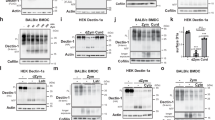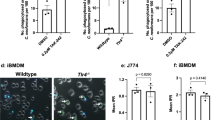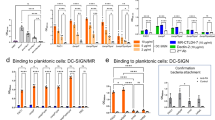Abstract
Innate immune cells must be able to distinguish between direct binding to microbes and detection of components shed from the surface of microbes located at a distance. Dectin-1 (also known as CLEC7A) is a pattern-recognition receptor expressed by myeloid phagocytes (macrophages, dendritic cells and neutrophils) that detects β-glucans in fungal cell walls and triggers direct cellular antimicrobial activity, including phagocytosis and production of reactive oxygen species (ROS)1,2. In contrast to inflammatory responses stimulated upon detection of soluble ligands by other pattern-recognition receptors, such as Toll-like receptors (TLRs), these responses are only useful when a cell comes into direct contact with a microbe and must not be spuriously activated by soluble stimuli. In this study we show that, despite its ability to bind both soluble and particulate β-glucan polymers, Dectin-1 signalling is only activated by particulate β-glucans, which cluster the receptor in synapse-like structures from which regulatory tyrosine phosphatases CD45 and CD148 (also known as PTPRC and PTPRJ, respectively) are excluded (Supplementary Fig. 1). The ‘phagocytic synapse’ now provides a model mechanism by which innate immune receptors can distinguish direct microbial contact from detection of microbes at a distance, thereby initiating direct cellular antimicrobial responses only when they are required.
This is a preview of subscription content, access via your institution
Access options
Subscribe to this journal
Receive 51 print issues and online access
$199.00 per year
only $3.90 per issue
Buy this article
- Purchase on Springer Link
- Instant access to full article PDF
Prices may be subject to local taxes which are calculated during checkout




Similar content being viewed by others
References
Goodridge, H. S., Wolf, A. J. & Underhill, D. M. Beta-glucan recognition by the innate immune system. Immunol. Rev. 230, 38–50 (2009)
Kerrigan, A. M. & Brown, G. D. Syk-coupled C-type lectin receptors that mediate cellular activation via single tyrosine based activation motifs. Immunol. Rev. 234, 335–352 (2010)
Ferwerda, B. et al. Human dectin-1 deficiency and mucocutaneous fungal infections. N. Engl. J. Med. 361, 1760–1767 (2009)
Plantinga, T. S. et al. Early stop polymorphism in human DECTIN-1 is associated with increased Candida colonization in hematopoietic stem cell transplant recipients. Clin. Infect. Dis. 49, 724–732 (2009)
Saijo, S. et al. Dectin-1 is required for host defense against Pneumocystis carinii but not against Candida albicans . Nature Immunol. 8, 39–46 (2006)
Taylor, P. R. et al. Dectin-1 is required for β-glucan recognition and control of fungal infection. Nature Immunol. 8, 31–38 (2007)
Dennehy, K. M. et al. Syk kinase is required for collaborative cytokine production induced through Dectin-1 and Toll-like receptors. Eur. J. Immunol. 38, 500–506 (2008)
Gantner, B. N., Simmons, R. M., Canavera, S. J., Akira, S. & Underhill, D. M. Collaborative induction of inflammatory responses by Dectin-1 and Toll-like receptor 2. J. Exp. Med. 197, 1107–1117 (2003)
Robinson, M. J., Sancho, D., Slack, E. C., LeibundGut-Landmann, S. & Reis e Sousa, C. Myeloid C-type lectins in innate immunity. Nature Immunol. 7, 1258–1265 (2006)
Brown, G. D. et al. Dectin-1 is a major β-glucan receptor on macrophages. J. Exp. Med. 196, 407–412 (2002)
Underhill, D. M., Rossnagle, E., Lowell, C. A. & Simmons, R. M. Dectin-1 activates Syk tyrosine kinase in a dynamic subset of macrophages for reactive oxygen production. Blood 106, 2543–2550 (2005)
Czop, J. K. & Austen, K. F. A beta-glucan inhibitable receptor on human monocytes: its identity with the phagocytic receptor for particulate activators of the alternative complement pathway. J. Immunol. 134, 2588–2593 (1985)
Goodridge, H. S., Simmons, R. M. & Underhill, D. M. Dectin-1 stimulation by Candida albicans yeast or zymosan triggers NFAT activation in macrophages and dendritic cells. J. Immunol. 178, 3107–3115 (2007)
Adams, E. L. et al. Differential high-affinity interaction of Dectin-1 with natural or synthetic glucans is dependent upon primary structure and is influenced by polymer chain length and side-chain branching. J. Pharmacol. Exp. Ther. 325, 115–123 (2008)
Fooksman, D. R. et al. Functional anatomy of T cell activation and synapse formation. Annu. Rev. Immunol. 28, 79–105 (2010)
Hermiston, M. L., Zikherman, J. & Zhu, J. W. CD45, CD148, and Lyp/Pep: critical phosphatases regulating Src family kinase signalling networks in immune cells. Immunol. Rev. 228, 288–311 (2009)
Lin, J. & Weiss, A. The tyrosine phosphatase CD148 is excluded from the immunologic synapse and down-regulates prolonged T cell signalling. J. Cell Biol. 162, 673–682 (2003)
Zhu, J. W., Brdicka, T., Katsumoto, T. R., Lin, J. & Weiss, A. Structurally distinct phosphatases CD45 and CD148 both regulate B cell and macrophage immunoreceptor signalling. Immunity 28, 183–196 (2008)
Brown, G. D. et al. Dectin-1 mediates the biological effects of β-glucans. J. Exp. Med. 197, 1119–1124 (2003)
Fuller, G. L. et al. The C-type lectin receptors CLEC-2 and Dectin-1, but not DC-SIGN, signal via a novel YXXL-dependent signalling cascade. J. Biol. Chem. 282, 12397–12409 (2007)
Kerrigan, A. M. et al. CLEC-2 is a phagocytic activation receptor expressed on murine peripheral blood neutrophils. J. Immunol. 182, 4150–4157 (2009)
Goodridge, H. S. et al. Differential use of CARD9 by dectin-1 in macrophages and dendritic cells. J. Immunol. 182, 1146–1154 (2009)
Feng, D. et al. Stepping into the third dimension. J. Neurosci. 27, 12757–12760 (2007)
Lavigne, L. M., Albina, J. E. & Reichner, J. S. Beta-glucan is a fungal determinant for adhesion-dependent human neutrophil functions. J. Immunol. 177, 8667–8675 (2006)
Acknowledgements
We thank K. Wawrowsky for help with confocal microscopy, and G. D. Brown for Dectin-1-deficient mice. This study was funded by grants from the NIH (AI071116 and AI066120 to D.M.U. and A.W., respectively) and the American Heart Association (D.M.U.). H.S.G. held a Research Fellowship Award from the Crohn’s and Colitis Foundation of America. D.M.U. holds the Janis and William Wetsman Family Chair in Inflammatory Bowel Disease at Cedars-Sinai Medical Center.
Author information
Authors and Affiliations
Contributions
H.S.G. and D.M.U. designed the study; H.S.G., C.N.R., C.A.B., J.M., A.J.W., N.B., A.S.H.C. and D.M.U. performed the experiments; A.S.M., M.E.D. and J.P.V. purified, characterized and provided the β-glucans; T.R.K. and A.W. provided knockout mice and an antibody; T.R.K., A.W. and J.P.V. gave technical support and conceptual advice; H.S.G. and D.M.U. wrote the paper.
Corresponding author
Ethics declarations
Competing interests
The authors declare no competing financial interests.
Supplementary information
Supplementary Information
This file contains Supplementary Figures 1-33 with legends, additional references and full legends for Supplementary Movies 1-2. (PDF 7076 kb)
Supplementary Movie 1
This movie shows confocal microscopy imaging of the formation of a “phagocytic synapse” upon binding of a yeast particle to Dectin-1 on the surface of a macrophage - see Supplementary Information file for full legends. (MOV 3419 kb)
Supplementary Movie 2
This movie shows 3D modeling of a “phagocytic synapse” in a phagocytic cup formed at the surface of a macrophage upon detection of a yeast particle by Dectin-1 - see Supplementary Information file for full legends. (MOV 1396 kb)
Rights and permissions
About this article
Cite this article
Goodridge, H., Reyes, C., Becker, C. et al. Activation of the innate immune receptor Dectin-1 upon formation of a ‘phagocytic synapse’. Nature 472, 471–475 (2011). https://doi.org/10.1038/nature10071
Received:
Accepted:
Published:
Issue Date:
DOI: https://doi.org/10.1038/nature10071
This article is cited by
-
Dectin-1 ligands produce distinct training phenotypes in human monocytes through differential activation of signaling networks
Scientific Reports (2024)
-
Fungal polysaccharides from Inonotus obliquus are agonists for Toll-like receptors and induce macrophage anti-cancer activity
Communications Biology (2024)
-
Inflammasome activation under high cholesterol load triggers a protective microglial phenotype while promoting neuronal pyroptosis
Translational Neurodegeneration (2023)
-
Physiology and diseases of tissue-resident macrophages
Nature (2023)
-
Dectin-1 signaling on colonic γδ T cells promotes psychosocial stress responses
Nature Immunology (2023)
Comments
By submitting a comment you agree to abide by our Terms and Community Guidelines. If you find something abusive or that does not comply with our terms or guidelines please flag it as inappropriate.



